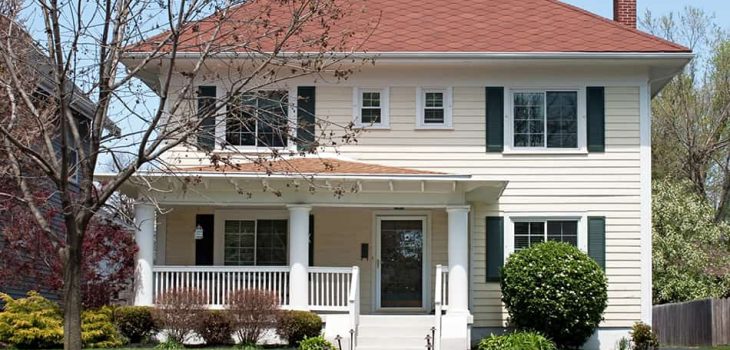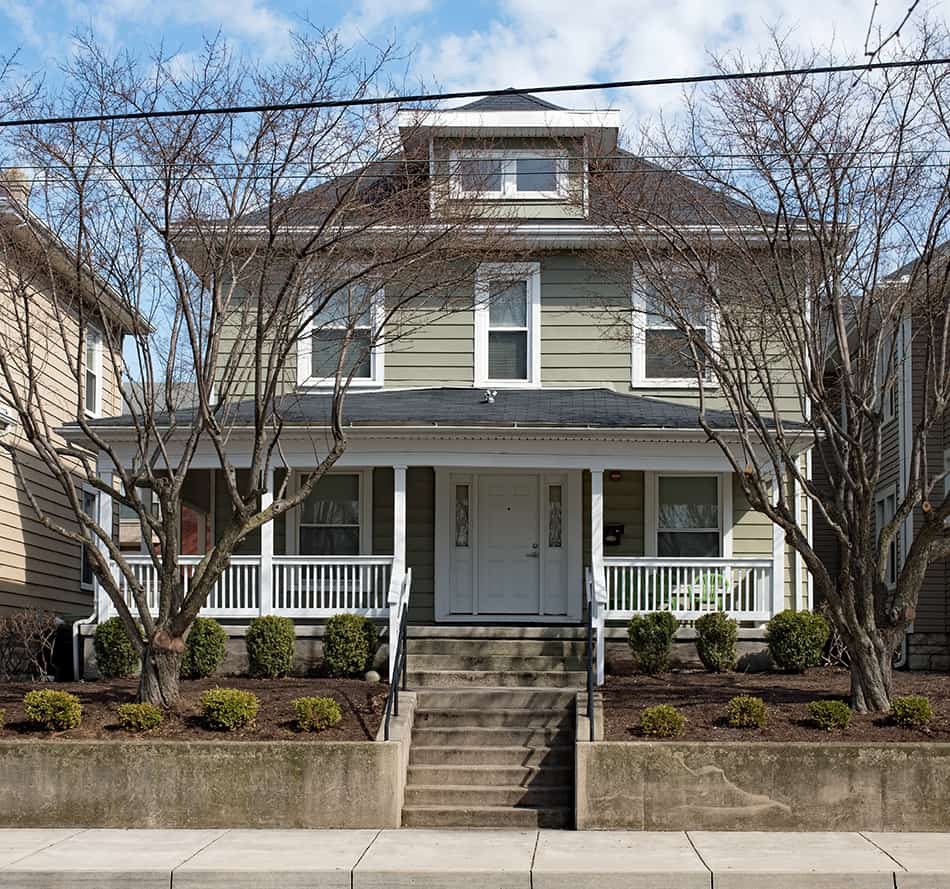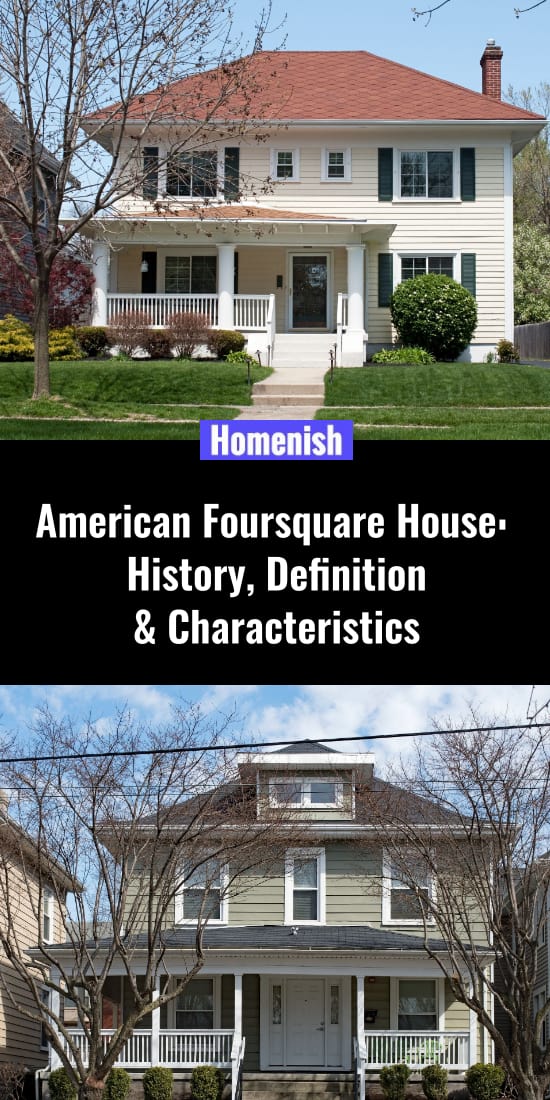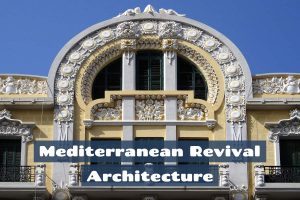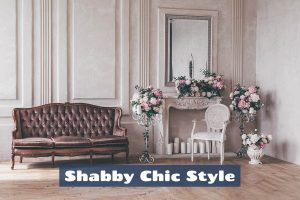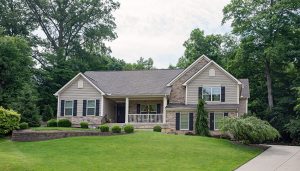Also known as the Prairie Box, the American foursquare is considered to be a true American style home. Economical, resource-efficient, and practical, foursquare homes can be seen in almost every US state as well as throughout Canada. It can safely be said that foursquares are the most common and popular house styles in America, providing comfortable housing for growing middle-class families. Being one of the most widely built homes of the early 20th century, the American foursquare is everyone’s favorite for a number of reasons. In this article, learn all about the history of American foursquares, their main characteristics, and the reasons for their popularity.
History of American Foursquares
The American foursquare was constructed from 1890 until 1935, just before World War II ended. These houses were one of the most popular styles in both small cities and rural areas. The inspiration behind the foursquare was the Prairie-style architecture that was introduced by Frank Lloyd Wright. The low-pitched roof of a foursquare was at the time considered a modern design, hence the reason this style home is also referred to as the Prairie Box.
The foursquares were not only economical to build, but they were aesthetically pleasing due to their simple design and layout. While some people may argue that a foursquare isn’t a true style, it is thought to have borrowed its design from the Colonial Revival and the Italianate style of the mid 19th century. Many of these homes also consisted of similar characteristics as the foursquares, such as columns, tile roofs, and exposed rafter tails.
American foursquares can be found almost anywhere in the US, from farmhouses in rural areas to urban settings and coastal properties, but they were notably made popular in the Midwest. Thanks to their square shapes and sizes, they could easily fit in small and narrow city lots. Growing families especially found the foursquares desirable in country settings where they required more space for their children. All in all, these homes continue to be just as popular to live in today as they were a century ago.
Why are Foursquares so Square?
Unlike the Victorian homes that featured complex floor plans and irregular rooflines with several gables, by the turn of the century, property builders started seeking cheaper and simpler residential construction forms, and that’s when foursquares were introduced. These two-storey homes had four large rooms on each floor and none of the decorated gables that featured in Victorian houses. Instead, the gable was replaced by a sloped hip roof that came down to all four sides of the property. The square shape made these homes very practical for narrow city streets. Since the rooms were arranged in quadrants, there was no need for long hallways, thus the interior space was made better use of.
An Overview of the Foursquare Characteristics
- 2 or more stories
- Simple floor plan
- Cubic or boxy shape
- Full-width front porch with up to 4 supporting columns
- Pyramidal hipped roof with wide eaves
- Symmetrical exterior
- Large central dormer
- Large double-hung windows with leaded glass
- Full-size unfinished basement
The American Foursquare Characteristics in Detail
Size
The size of the American foursquare is medium compared to Victorian-style homes. Most foursquares feature a full basement and an unfinished half-story attic above the second floor, which in theory could double the habitable space as an extra bedroom. Since these homes typically have an upper story attic, they look taller and larger than they actually are.
Exteriors
- The shape: as mentioned before, the American foursquare has a cube-like shape that looks exactly like a box. Even if it has a front porch, wing, or veranda, the basic shape is always the same; square.
- The upper perimeter: the upper part of the house has overhanging eaves that are meant to complete the whole look as well as provide shade for the second story bedrooms. The rooflines of these large eaves are a pyramidal shape and because of their inexpensive design, they don’t particularly stand out – not even next to the chimney, which is usually made of concrete or brick. There is also an extended front dormer, which is the hallmark of the foursquare and allows plenty of natural light into the attic.
- The lower perimeter: multiple columns surround the front part of the house with the porch appearing within them. The stairs lead up to the front door, with feature windows at both ends of the door.
- Windows: double-hung windows that are in simple shapes and can easily be opened for ventilation. The lower half of the windows contain plain or leaded glass, while the upper half features smaller panes in one single frame. The windows are large in order to allow as much air and light in as possible. Leaded glass softens the warmth of the sunlight and in the years before air conditioning, double-hung windows were the best alternative as they could be opened at the top and bottom.
- The Porch: A full front porch that was inspired by Craftsman style homes is another defined characteristic of the foursquare. Although these porches aren’t as intricately detailed as the Victorian style, they were, nevertheless, a prominent part of every foursquare home. In fact, you can see such porches stand out beautifully as they extended the entire front exterior, providing shade and a place to sit and reflect.
Interiors
- The first floor: a traditional foursquare usually contains a foyer (not a hallway) on the first floor, where it often leads to the second floor via the stairs. There is also a kitchen, a dining room, and living room. At the rear of the property, there is the possibility of adding a one-story extension to make the kitchen larger or add a laundry room to accommodate the kitchen.
- The second floor: there are usually four bedrooms and a family bathroom. Although smaller foursquares have three bedrooms and a bathroom on the second floor. The layout of the rooms are so efficient that no space is wasted. Since most foursquares have half-size attics on the upper floor, the homeowner can enjoy extra storage space or an additional bedroom if there is adequate head space.
- The finishes: just like the modern Craftsman style, the interiors of foursquares are finished with earthy, neutral colors to look as natural as the wooden flooring and plaster walls, which were the norm for that era.
- The styling: the interior style is simple and largely focused on natural light. Foursquares often have finely crafted woodwork in every room with plenty of natural light coming in from all directions. There are also integrated bookshelves and window seats with handcrafted wooden cabinets that accentuate the rooms.
Color Scheme
Since the popularity of the American foursquare spanned many decades, it is difficult to summarize the most commonly used colors with the ever changing taste of home buyers. Foursquares were designed not to be showy. They were exactly what the Queen Anne homes of Victorian styles weren’t. Rather than boasting multiple colors in each and every detail of the property, the foursquares were more earthy, muted grey colors. This neutral color scheme means the homeowner can easily transform their foursquare’s exterior with any color they like.
Advantages of American Foursquares
- Economical to build: the cost of foursquare’s materials were very affordable since it was standard to use wood for the floors and plaster for the walls. Since builders only relied on one of two standard construction plans, they saved time and money on acquiring an architect to design such houses. These homes were one of the most affordable housing options for middle class families in the US. Compared to how expensive it was to build ornate Victorian homes, it’s no wonder why so many people decided to opt for a simpler and cheaper alternative.
- Space-saving: the interior of foursquares made the most use of space as there were no narrow hallways downstairs or upstairs.
- Highly adaptable: since the foursquare’s features were very basic and simple, it provided the homeowner the freedom to personalize the house with any architectural style they desired. For example, if you love a Victorian home but can’t afford to buy one, a foursquare house can easily be adapted to feature the same style.
- Earthy craftsmanship: foursquares were the best examples of the shift towards simpler craftsmanship and away from the dramatic Victorian era.
Looking for drawbacks of foursquares? There aren’t any! Feel free to share your thoughts on this in the comments section below.
Final Thoughts
The American foursquare style homes are seen as the modern-day Georgian houses, but in a more practical version. This style house took its characteristics from Italian Renaissance, Colonial Revival, and Neoclassical homes and although it was no longer constructed after World War II, in many eastern cities of the US, the foursquare remained as the dominant residential design. Foursquares were built to meet the needs of growing families and today, they are still the simple and solid homes that we continue to love today.
